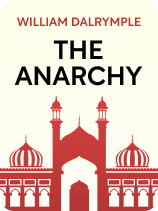

This article is an excerpt from the Shortform book guide to "The Anarchy" by William Dalrymple. Shortform has the world's best summaries and analyses of books you should be reading.
Like this article? Sign up for a free trial here.
How did a trading company, ostensibly formed for commerce, come to rule most of the Indian subcontinent and its millions of people for over 50 years? What impact did it make?
The Anarchy by William Dalrymple charts the rise of the English East India Company (EIC) during the 17th and 18th centuries. Dalrymple explains how it rose from a small outfit of merchants into the imperialist superpower that established British colonial rule in India.
Continue reading for an overview of this fascinating book.
Overview of The Anarchy by William Dalrymple
The Anarchy by William Dalrymple explains that the EIC rose by exploiting a period of chaos and instability in India—when the once-powerful Mughal Empire had collapsed into smaller regional kingdoms that vied among themselves to fill the power vacuum. In the midst of this anarchy, the EIC forged alliances, backed coups, installed puppet rulers, leveraged new military technology, and built the largest army on earth.
Furthermore, the company exploited its position as a joint-stock company—a role that afforded it independence from the oversight of the British government, but still entitled it to lobby its government for bailouts and military support. The EIC’s rule dramatically transformed India and the world. As well as setting the stage for British rule, the company also reversed the global flow of trade that had been in place for centuries, exacerbated one of history’s worst famines, triggered a financial crisis in Europe, and reshaped Indian society for generations.
First, we’ll explain the conditions that enabled the EIC’s rise, then we’ll follow its rise to power in Bengal. We’ll discuss its rule in Bengal and then explore its rise in India writ large.
Dalrymple is an award-winning Delhi-based historian who grew up in Scotland and has written extensively on European colonialism in the Eastern hemisphere, including documentaries for radio and television. His work draws heavily on Mughal and French primary sources to present a fuller picture than previous histories, which relied primarily on English sources.
(Shortform note: The Anarchy received mostly positive reviews. Critics praised Dalrymple’s storytelling ability, vivid detail, and breadth of source material. However, reviewers were split on Dalrymple’s comparisons between the EIC and modern multinational corporations: Some agreed that this history provides important lessons for modern-day regulatory policy, while others felt he didn’t fully develop his argument regarding the differences between corporations then and now. Furthermore, critics pointed out that Dalrymple overemphasized elite decision-makers at the expense of discussing the ordinary people living through these events. Finally, others thought he could have done more to compare this history with other forms of imperialism to contribute to broader historical debates.)
Part 1: Setting the Stage (Early 17th to Mid 18th Centuries)
Before we chart the EIC’s rise to power, we’ll provide some context on conditions in India during the 17th century and what made it so attractive to British merchants. First, we’ll discuss how England took notice of the wealth in India and began trading within the powerful Mughal empire. Then we’ll explore the collapse of this empire, which created the conditions for the EIC’s rise.
England Sets Its Sights on India’s Wealth
Dalrymple explains that English traders were attracted to India’s vast wealth. By the 16th and early 17th century, the Mughal empire in India was one the richest on earth, second only to Ming China. The Mughals were a powerful Muslim ruling class that governed most of what’s now modern India through a network of tax collectors and officials backed by vast armies. Nobles, called Nawabs, ruled individual provinces and sent tribute back to the capital in Delhi. With India’s fertile soil for agriculture, vast workforce, and highly developed culture of artisans, the Mughal empire had become a major exporter of textiles and spices.
For centuries, the flow of international trade had brought gold, silver, and jewels into India in exchange for their exported goods, some of which made their way to Europe by trade routes through the Middle East. However, the price of these goods increased significantly as they progressed along the trade routes, and the goods that did reach Europe were exceedingly rare. Therefore, European traders stood to gain enormous profits by trading with India directly and cutting out the traders in between.
The Spanish, Portuguese, and Dutch took advantage of this opportunity first, and Dalrymple characterizes the English as latecomers trying to catch up. The EIC formed to trade with India in 1600. Queen Elizabeth I signed its charter, granting a trade monopoly that excluded rival English merchants over most of Eastern and southern Asia.
Britain Sets Up Shop In Mughal India
Dalrymple asserts that in the 17th century, the EIC was constrained by the power of the Mughals and carefully deferred to their authority. The EIC secured rights to build trading forts only after King James I of Great Britain sent an envoy to negotiate with the Mughal emperor Jahangir. Jahangir saw trade with Britain as a low priority. He rejected the company’s bid for an exclusive trade deal that would exclude Britain’s European rivals, but he eventually granted permission to trade.
Throughout the 17th century, the EIC carried out trade and quietly built more trading forts along the shores of India while remaining deferential to Mughal rule. Dalrymple explains that the Mughals commanded enormous armies and the British were in no position to cross them. The British took military action against the Mughals only once during this time. The Mughals retaliated by seizing most of the British forts, and the EIC had to apologize and renegotiate permission to continue trade.
The Mughal Empire Begins to Collapse
Around the early 18th century, the Mughal empire began to collapse. Dalrymple attributes this collapse to a wide range of forces. First, Mughal Emperor Aurangzeb began enforcing a stricter version of Quranic law, angering the Hindu majority. Then rebellions intensified throughout the empire, as Sikhs, Afghans, and Hindus began seizing territory.
After Aurangzeb’s death in 1707, a dispute broke out over who would succeed him, leading to assassinations, rapid turnover, and conflict between competing Mughal factions. Then a Persian general ransacked the capital of Delhi in 1739, depleting their treasury and damaging the Mughals’ reputation for power. One by one, provincial rulers—the Nawabs—began cutting ties with the capital. The independent provinces stopped sending tribute, undermining the empire’s finances. This fractured India into competing regional powers, inaugurating a period of war and instability.
Part 2: The Company Rises to Power in Bengal (Early to Mid-18th Century)
While the EIC didn’t cause the collapse of the Mughal empire, Dalrymple asserts that it became the primary beneficiary. No longer constrained by the powerful Mughals, the EIC expanded its trading operations and military capacity, adding forts and recruiting locals to serve as infantry. The EIC set its sights on Bengal, a wealthy province on India’s northeastern coast. We’ll explore the series of events that allowed the EIC to take advantage of political chaos to rise to power in Bengal.
Event #1: The English East India Company Challenges the Ruler of Bengal
The EIC began its rise to power in Bengal by first building up military capacity and then challenging the Mughal rulers. Here we’ll discuss these two key developments.
1) The Company Builds Up Military Capacity
Dalrymple states that the EIC originally began building up military capacity in Bengal to counter the French colonists, who had also been building capacity in the region. The British government sent military forces to India that were placed under the command of the EIC. This mutual arms race broke out into a series of wars between the EIC and the French in India called the Carnatic Wars. The British eventually prevailed against the French, establishing their dominance among European powers in the region.
However, this military buildup led to tensions with the Mughal rulers of Bengal. The Mughals didn’t approve of European colonists militarizing, and Siraj ud-Daula, the Nawab of Bengal at the time, called on both the British and French to disarm. The French responded diplomatically, diffusing tensions. On the other hand, the EIC responded defiantly, escalating tensions. Siraj attacked the British in response, capturing their fort in Calcutta and imprisoning British soldiers.
2) The Company Retaliates Against Siraj ud-Daula
As Dalrymple narrates, the EIC retaliated against the Mughal prince with a successful military campaign that expanded its influence. A young military commander named Robert Clive convinced the EIC board to formally declare war on Siraj. After a decisive battle where Siraj barely escaped with his life, the Nawab negotiated a treaty with the British. The EIC pressed for enormous privileges. As a condition of his surrender, Siraj let the EIC keep its forts, freed its goods of taxes, and allowed it to create its own mint and currency.
Event #2: The English East India Company Backs a Coup
Emboldened by its victory against Siraj, the EIC sought to expand its influence in Bengal by backing a coup in Bengal and installing a puppet ruler who would support its interests. Dalrymple explains that Mir Jafar, one of Siraj’s generals, planned to overthrow the Mughal prince and was looking for allies. The EIC was known throughout Bengal for its military prowess, and the Jagat Seths, a wealthy family of financiers, offered a vast sum of money to the EIC and Clive if they’d join Jafar in the coup. The EIC agreed, and Clive marched on the capital of Bengal with a force of English soldiers and sepoys—Indians who had been recruited into the company army and trained in British weaponry and tactics.
In its coup against Siraj, the EIC benefited from gaps in the other side’s military technology and experience with firearms—for example, EIC fighters knew to keep their gunpowder dry during a rainstorm with tarps, while their opponents, unfamiliar with firearms and their maintenance, didn’t. After defeating Siraj, the EIC installed Jafar as the Nawab of Bengal, but his dependence on EIC military power made the British the de facto rulers of the province. The Jagat Seths made good on their payment to Robert Clive, who returned to England the richest man in the country.
Bengal Under Jafar and the EIC
Dalrymple reports that the newly-installed Nawab Jafar’s reign went poorly. He had little legitimacy in the eyes of the Bengali citizenry—he’d never been a Mughal prince and had seized power in a violent coup with the help of foreign merchants. Furthermore, having spent his entire career in the military, Jafar had little aptitude for governing, and his administration was beset by financial problems. Jafar’s soldiers grew mutinous since he could no longer pay them.
The EIC benefited enormously from Jafar’s ineffectual rule. Without checks on its power, the EIC oppressed the Bengali population with impunity. The company extorted merchants into selling goods at unfair prices, and its soldiers bullied, robbed, and arrested Bengali citizens.
Event #3: The English East India Company Backs Another Coup
While the EIC enjoyed its impunity, the Jagat Seths were not pleased with Jafar’s flailing regime and decided to back a second coup. Dalrymple explains that Jafar had an ambitious son-in-law named Mir Qasim who thought he could do better. The Jagat Seths approved of him and asked the EIC to reprise its mercenary role. The EIC agreed, but this time, instead of a lump sum of cash, it asked for tax collection rights in several portions of Bengal. This effectively made it an independent governing force with a steady stream of revenue. Qasim and the Jagat Seths agreed to these terms, and the EIC deposed its own puppet Jafar in a second coup.
The EIC Legitimizes Its Coups
Dalrymple notes that, though the EIC had now carried out two successful coups, it still faced a significant gap in legitimacy. Fortunately for the company, a potential ally had made his way to Bengal and was interested in talks. Shah Alam was a young Mughal prince who had been heir to the throne in Delhi before being ousted by his cousin in a succession dispute. After Alam narrowly escaped an assassination attempt, a romantic legend sprang up around the exiled young prince, and he attracted thousands of followers who considered him the true heir to the Mughal throne. While the EIC had power without legitimacy, Shah Alam had legitimacy without power. Their complementary needs suggested a natural alliance.
The EIC and Shah Alam reached an agreement: The EIC and Mir Qasim would pledge their allegiance to Alam as the true heir of the Mughal empire. Alam would formally recognize Qasim as the legitimate ruler of Bengal, legitimizing both coups. Then, the EIC would use its military forces to help the young prince march on Delhi and take back his throne. However, after Alam legitimized the coups, the EIC dragged its feet on its end of the bargain. Frustrated with his new “allies,” Shah Alam left Bengal to join forces with Shuja ud-Daula, a Mughal prince ruling a neighboring kingdom.
Event #4: The English East India Company Overthrows Mughal Rule in Bengal
Dalrymple says the EIC soon grew tired of Qasim’s rule. A much more effective ruler than his father-in-law, Qasim raised taxes to balance the budget and pay soldiers their back wages. He rooted out corruption and built a strong administrative state. Qasim’s competence made him much harder to push around, and the EIC missed the impunity it had enjoyed under Jafar. Additionally, Qasim recognized the EIC as a rival and sought to counter its influence by eroding the privileges it had obtained from Siraj. The EIC voted to formally declare war on Qasim and reinstate Mir Jafar as Nawab of Bengal. Its military campaign prevailed and drove Qasim out of the region.
Event #5: The English East India Company Repels a Mughal Alliance
According to Dalrymple, the EIC would face one more challenge to establishing complete rule in Bengal: an alliance between three Mughal princes. After his defeat, Qasim fled Bengal with his remaining forces and, like Shah Alam, sought refuge with Shuja ud-Daula. He then proposed an alliance between himself, Shuja, and Shah Alam to drive out the English.
The three princes assembled an enormous force and marched toward Bengal. However, the EIC managed to repel their attack, largely due to a crack in the princes’ alliance. Dalrymple explains that Shah Alam wasn’t fully committed to the alliance. Since Qasim and the EIC had both declared allegiance to him, the young prince saw this as merely a dispute between his subjects—and secretly remained in communication with the EIC. Thus, while Shuja’s troops charged into battle, Shah Alam’s held back, and Shuja’s army failed to defeat the EIC on its own. With the alliance fragmented, the EIC launched a successful counteroffensive and defeated Shuja’s army, cementing its rule in Bengal.
Part 3: The Company Rules Bengal (Mid- to Late 18th Century)
Now that we’ve discussed the EIC’s rise to power in Bengal, we’ll explore how it maintained power and governed the province. We’ll also describe the consequences of its policies, which drained the economy of Bengal, led to a disastrous famine, and triggered a financial crisis in Europe. Finally, we’ll discuss Britain’s reaction to company rule, which led to a shift toward more government oversight for the EIC.
How Did the Company Govern?
Dalrymple states that the EIC established rule over Bengal by carefully maintaining the old Mughal hierarchies. The tax collectors, soldiers, petty officials, and law agents were all the same as before. However, EIC men now sat at the top of every hierarchy.
This was done because 1) the company didn’t have enough personnel to run the Bengal state on its own, and 2) EIC members knew that ordinary Bengalis would be less likely to revolt if the new regime looked more or less like the old one. The EIC also consolidated its rule by maintaining alliances with the Mughal princes it had just defeated.
A second key component of the EIC’s governance consisted of systematically draining wealth from the Bengal economy. Though it now ruled a territory and subjects, the EIC still saw itself as mainly a joint-stock corporation whose primary responsibility was to its shareholders. Thus, the company sent as much wealth as possible back to England. The EIC used the tax revenue of the Bengali people as another stream of business revenue, spending most of it on trade goods bound for resale in England.
What Were the Consequences of the Company’s Rule?
Dalrymple argues that the EIC’s policies of wealth extraction had disastrous consequences for Bengal. Since none of the extracted wealth was reinvested in building the local economy, the province slowly became poorer and poorer. The EIC had reversed the flow of capital that had been coming into India since the earliest days of the spice trade. Now, money flowed from India to Europe at an alarming rate. In less than a decade of EIC rule, Bengal, once the wealthiest province in India, became one of the poorest. This led to two catastrophic events: the Great Bengal Famine and a financial crisis in Europe.
1) The Great Bengal Famine
Dalrymple asserts the EIC’s neglectful governance and economic pillaging paved the way for the Great Bengal Famine, one of the worst disasters in the region’s history. In 1768-69, Bengal suffered its worst drought in years, and 70% of crops failed. Farmers started selling everything they owned, and the poorer laborers starved to death.
While the EIC’s Mughal predecessors had maintained storehouses of grain to prepare for droughts, the company had no famine relief program at all. The company board didn’t see this as the company’s problem, and it continued ruthlessly enforcing taxation to protect its bottom line. Though not an official company policy, private traders within the company also began hoarding grain to sell at exorbitant monopoly prices, making fortunes off the famine. An estimated 1.2 million people died, yet the company responded indifferently when locals tried to raise the alarm.
2) The Financial Crisis in Europe
Dalrymple asserts that these catastrophes set off a chain reaction that ultimately plunged Europe into a financial crisis. First, the destruction of Bengal’s economy dried up the EIC’s revenues. When Bengali citizens couldn’t pay taxes, the EIC lost much of its income. As a result, the company struggled to meet its financial obligations, defaulting on customs fees and loan payments back in Europe. As news of its failing finances spread, the company’s share price started to fall. Many European bankers had overinvested in EIC stock, and the company’s sudden decline caused over 30 banks to fail, triggering a recession across Europe.
How Did the British Parliament Respond to the Famine and Financial Crisis?
The British Parliament realized it needed to control the damage done by the EIC’s financial policies. Dalrymple explains that the Parliament’s response fundamentally reshaped the relationship between the EIC and the British government.
This response sought to balance several competing motivations. First, the British elites realized both the value of Bengal to Britain’s economy and the liability of leaving it in the hands of a trading corporation. Furthermore, the EIC developed a bad reputation for violence and greed, even in England—leading to calls for greater government oversight from public critics and concerned officials. However, the British Parliament also sought to keep the EIC financially solvent. Britain’s economy was heavily intertwined with the company, and Dalrymple highlights that 40% of members of Parliament personally owned EIC stock.
The British Parliament first balanced the company’s finances with a £1.4 million bailout in 1773, a sum unheard of at the time. Second, Britain claimed the right to appoint governors in Bengal and selected Warren Hastings, a reformer in the company who had tried to blow the whistle on the destruction in Bengal. This set in motion a process of gradually increasing government oversight and control that would continue over the next century.
Part 4: The Company Rises to Power in India (Late 18th to Early 19th Centuries)
Bengal wasn’t the only part of India where the EIC had established itself by the time of the Bengali Famine and Britain’s reassessment of its interests. Dalrymple states that the company had also begun asserting itself on the larger stage of regional powers vying for control of the greater Indian subcontinent. We’ll take a look at the parallel empire building that paved the way for government control when Parliament ratcheted up its oversight of the EIC in the ensuing years. Specifically, the EIC rose to power in greater India through a series of wars against two major powers: the Mysore Sultanate and the Maratha Confederacy.
Conflict #1: The Anglo-Mysore Wars (1767-1799)
First, the EIC fought a series of wars against the Mysore Sultanate, leading to a dramatic expansion of its territory and resources. Dalrymple clarifies that the Mysore Sultanate was a powerful kingdom based in southern peninsular India and ruled during the late 18th century first by Hyder Ali and then by his son Tipu Sultan. The Mysore Kingdom commanded significant resources: It possessed superior numbers of troops and had narrowed the gap in military technology and tactics with assistance from French mercenaries. Additionally, the Kingdom had built its own munitions factories and artillery, funded by a strong silk-based economy. Lastly, Mysore had forged effective alliances, first with the Marathas and a central kingdom called Hyderabad, and then later with the French.
The Course and Outcome of the Wars
At first, Mysore succeeded at challenging British power in southern and eastern India, but Dalrymple explains that the war turned against it. The EIC suffered its first major defeat in India when Mysore marched on Bengal with 50,000 troops. Failing to repel the attack, the British bought off Mysore with an enormous tribute. However, over the next 30 years, under the commands of Warren Hastings, George Cornwallis, and eventually Richard Wellesley, the British took several steps which allowed them to overcome the Mysore Sultanate and conquer its territory:
- First, the company broke Mysore’s alliance by signing its own treaty with Mysore’s Maratha allies.
- Then it led a successful counteroffensive into Mysore territory. Tipu Sultan surrendered and Cornwallis extracted severe concessions, including 30 million rupees, half of Mysore’s territory, and two of Tipu’s sons as collateral.
- Next, the EIC neutralized Mysore’s French allies by stealthily surrounding their primary army with artillery and demanding a surrender.
- Finally, the EIC led a decisive campaign to conquer the other half of Mysore territory, overwhelming the capital of Srirangapatnam with artillery and killing Tipu Sultan in battle.
This victory led to a vast expansion of the EIC’s power. The company’s territory more than doubled and it appropriated much of the Sultanate’s wealth. Furthermore, it assimilated troops from Tipu’s former armies into its own, growing its total forces to over 155,000 troops, a greater force than the entire military of Britain.
Conflict #2: The Anglo-Maratha Wars (1775-1803)
Finally, the EIC established its rule in India by waging war against the Marathas, a powerful confederacy of Hindu kingdoms based in western India. Dalrymple explains that the Maratha rebellions had been the greatest contributors to the Mughals’ downfall, and that much of the former Mughal empire, including the capital of Delhi, now lay in their hands. The EIC’s first attempt to conquer the Marathas resulted in a decisive British defeat and the full return of captured territories in 1782. However, in its conquest of the Mysore Sultanate, the EIC acquired the resources to challenge the Marathas a second time. The company declared war on the Maratha Confederacy in 1803, led by Governor Richard Wellesley, his younger brother Arthur Wellesley, and General Gerard Lake.
Dalrymple identifies three major factors that determined the course of the conflict.
- Division: At the conflict’s outset, the Marathas had fallen into a bitter civil war and thus couldn’t challenge the British with a united front. The EIC then stoked these divisions, signing a treaty with one of the weaker factions to further divide the alliance.
- Technology: The British continued implementing new military technologies. For example, they began using “galloper guns”—horse-drawn artillery that could move into position faster than conventional cannons.
- Finances: Many of India’s biggest money-lending families began backing the company over the Marathas because of its large collateral and record of repayment. The EIC leveraged this capital to bribe the Marathas’ French and Arab mercenaries into abandoning their posts, surrendering forts, and even joining the EIC army.
With these advantages, the EIC marched on Delhi and captured it from the Marathas. Dalrymple argues that this was the turning point in the war: Though the Marathas would continue resisting, the fall of Delhi established the EIC as the dominant power in the region.
Part 5: Consolidation of British Power (Early to Mid-19th Century)
A private corporation, initially created for trade, now controlled half a million square miles and ruled over millions of subjects. Dalrymple explains that in 1803, the EIC consolidated its power by once again installing a puppet ruler who could lend a veneer of legitimacy to its regime. To do so, the company turned once more to Shah Alam, the exiled Mughal prince who had played a similar role in legitimizing the company’s rule in Bengal and by now was an old man. The EIC tried to publicly frame its rule as a “reinstatement” of Shah Alam and a restoration of Mughal power—though in reality, the old Mughal state was now firmly under British command.
Dalrymple asserts that the EIC’s consolidation of power ultimately cleared the way for British rule in India. The British Parliament had already started questioning the wisdom of trusting Britain’s most important colony to a private company, and the increasing government oversight slowly transformed the company’s administration into a state-run enterprise. The British government officially took over in 1858, after a war for Indian independence stirred fears that the company was losing control of its empire. Nonetheless, Dalrymple asserts, the fall of Delhi truly marked the culmination of the EIC’s rise to power. The period of anarchy following the collapse of the Mughal empire was ending, and a new era of British dominion was beginning.
Exercise: Reflect on the Themes of The Anarchy
This exercise will give you a chance to reflect on the major themes of The Anarchy and your interpretation of key events.
- Compare the English East India Company to multinational corporations today. In what ways are they different, and in what ways are they the same?
- Most of the world has been impacted by the legacy of colonialism. Are there any parallels between these events and the history of your country or region? Consider how these histories may be similar and different.
- What, if anything, do you think could have been done to prevent the English East India Company’s rise to power in India? Explain your response.
- Over the years, there’s been a growing movement of voices in India calling for reparations from Britain for centuries of colonialism. In particular, many of these calls have focused on the repatriation of looted artifacts, many of which are now housed in British museums and private collections—including the crown jewels. After reading this history, do you feel these calls are warranted? Why or why not?

———End of Preview———
Like what you just read? Read the rest of the world's best book summary and analysis of William Dalrymple's "The Anarchy" at Shortform.
Here's what you'll find in our full The Anarchy summary:
- How the English East India Company grew during the 17th and 18th centuries
- Why a trading company came to rule most of the Indian subcontinent
- The background, historical context, and fallout from the events in the book






